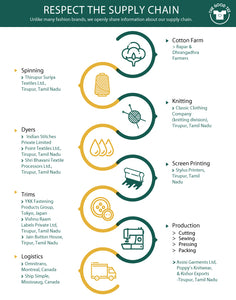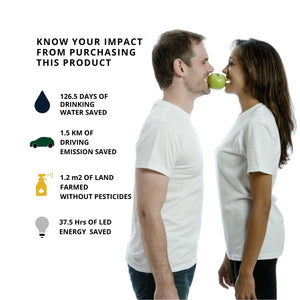TAKING GOOD CARE OF YOUR CLOTHES: "GREEN" WASHING INSTRUCTIONS 101
We live in a world obsessed with laundering an item after a single-use. Yet doing the laundry has a huge environmental impact on the planet.
Good news! Up to two-thirds of clothes’ carbon footprint occurs after you take it home. That’s awesome because most of the nasty stuff in the fashion industry is in your hands to fix. The extra good news is that it’s not even hard stuff to do.
LET’S TAKE A GOOD LOOK
- Energy. It takes a lot of energy to heat the wash water and then run the dry cycle. Because both emit carbon dioxide - doing the wash with hot water, then finishing with a hot spin-dry, contributes to greenhouse gases and global warming.
- Water. The average family does around 400 loads of laundry each year. According to Energy Star, these 400 loads consume around 3,500 gallons of water. Conserving water is vital now - and will be more so in the future.
- Toxins. Unless natural, most detergents and softeners have chemicals - Sodium Lauryl Sulfate, Phosphates, Formaldehyde and Chlorine Bleach are just some of the culprits. These chemicals leach into our water supply and can harm the health of people, pets and the environment.
- Microplastics. Derived from plastic-based synthetics such as polyester and nylon, microplastics get washed out to sea in the rinse water and when consumed by fish, seep into the food chain. Naturally, products from The Good Tee are chemical - and plastic-free!
Good Washing Tips:
1. Wear Natural
Synthetic fabrics such as polyester trap odours at a greater rate than natural fibres like cotton so if you want to feel (and smell) fresh, go natural! (perhaps organic?)
2. Spot Clean
Remove splashes and stains as they happen and before they soak in.
3. Use Eco-Friendly Detergent
Look for labels that indicate a product is phosphate-free, readily biodegradable, and made from plant- and vegetable-based ingredients. You can also make your own detergents.
4. Wash Full Loads
Don’t fall into the trap of thinking you need to wash a garment after each wear. Reducing the number of loads saves water, energy and money.
5. Use An Energy Efficient Washing Machine
You can save up to 50,000 litres of water per year and a lot of energy!
6. Wash in Cold
90% of the energy used for washing clothes goes into heating the water. Switching from hot to cold or warm water can help prevent 500 lbs of CO2 from entering the atmosphere every year.
7. Nix the Dryer
In summer, line dry outside. In winter, use a rack and let your washing dry in the boiler room/den.
8. Skip The Iron
Ironing consumes energy and can reduce the longevity of the fabric.
9. Repair/Donate
Fashion waste clogs our landfills, but there are ways to help end that. Slight tear, or moth hole? Pick up the needle and thread and darn it! Big rip, broken zip, or no good at “repair,” your local dry cleaner or seamstress friend might be able to help! When your garment is done - ask yourself if you can you give the fabric a second life - think cleaning rags, stuffing, art and craft materials, etc. Still in good condition? Wash and donate to give back programs so they can recycle or reclaim the fibre.
10. Our Labels are Designed to help you do good

The power of low-impact laundry and eco-wash is in your hands. It’s easy. And you can make a difference.
Did we miss anything out? Got any “hot” washing tips?
Author: Adila Cokar







Leave a comment